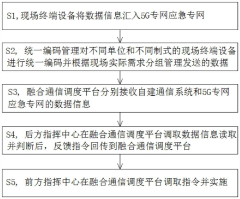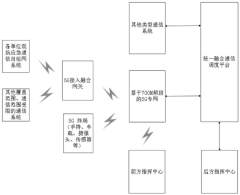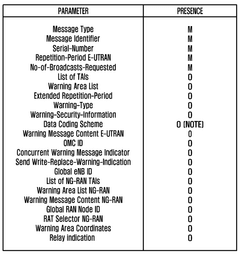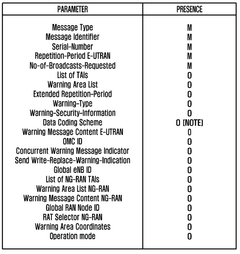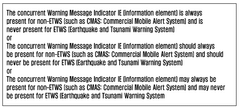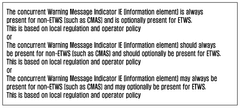How 5G UC Enhances the Efficiency of Emergency Response Systems
JUL 18, 20259 MIN READ
Generate Your Research Report Instantly with AI Agent
Patsnap Eureka helps you evaluate technical feasibility & market potential.
5G UC Emergency Response Background and Objectives
The evolution of emergency response systems has been a critical focus in public safety and disaster management. As technology advances, the integration of 5G Ultra-Capacity (UC) networks presents a transformative opportunity to enhance the efficiency and effectiveness of these systems. The primary objective of this technological advancement is to leverage the high-speed, low-latency capabilities of 5G UC to revolutionize how emergency services operate and respond to crises.
5G UC technology represents a significant leap forward in wireless communication, offering unprecedented data transfer speeds, reduced latency, and increased network capacity. These features are particularly crucial in emergency scenarios where every second counts. The goal is to harness these capabilities to create a more responsive, coordinated, and intelligent emergency response infrastructure.
Historically, emergency response systems have been limited by communication constraints, often relying on outdated technologies that struggle to handle the complexities of modern emergencies. The introduction of 5G UC aims to address these limitations by providing a robust platform for real-time data exchange, advanced analytics, and seamless coordination among various emergency services.
One of the key objectives in implementing 5G UC in emergency response systems is to enable faster and more accurate situational awareness. This involves the rapid transmission of high-definition video feeds, real-time sensor data, and detailed mapping information to emergency responders and command centers. By doing so, decision-makers can have a comprehensive understanding of the emergency situation, allowing for more informed and timely responses.
Another critical goal is to enhance communication and coordination among different emergency services. 5G UC's network slicing capability allows for the creation of dedicated, high-priority channels for emergency communications, ensuring that vital information is transmitted without interruption or delay. This seamless integration of various emergency services can significantly improve response times and resource allocation.
The implementation of 5G UC also aims to support advanced technologies such as artificial intelligence and machine learning in emergency response scenarios. These technologies can analyze vast amounts of data in real-time, providing predictive insights and automated decision-support systems to emergency responders. This integration of cutting-edge technologies with 5G UC infrastructure is expected to revolutionize how emergencies are managed and mitigated.
As we explore the potential of 5G UC in emergency response systems, it is essential to consider the broader implications for public safety and disaster management. The technology promises not only to improve the efficiency of emergency responses but also to enhance the overall resilience of communities in the face of various threats and disasters. The journey towards fully integrating 5G UC into emergency response systems represents a significant step forward in our ability to protect and serve the public in times of crisis.
5G UC technology represents a significant leap forward in wireless communication, offering unprecedented data transfer speeds, reduced latency, and increased network capacity. These features are particularly crucial in emergency scenarios where every second counts. The goal is to harness these capabilities to create a more responsive, coordinated, and intelligent emergency response infrastructure.
Historically, emergency response systems have been limited by communication constraints, often relying on outdated technologies that struggle to handle the complexities of modern emergencies. The introduction of 5G UC aims to address these limitations by providing a robust platform for real-time data exchange, advanced analytics, and seamless coordination among various emergency services.
One of the key objectives in implementing 5G UC in emergency response systems is to enable faster and more accurate situational awareness. This involves the rapid transmission of high-definition video feeds, real-time sensor data, and detailed mapping information to emergency responders and command centers. By doing so, decision-makers can have a comprehensive understanding of the emergency situation, allowing for more informed and timely responses.
Another critical goal is to enhance communication and coordination among different emergency services. 5G UC's network slicing capability allows for the creation of dedicated, high-priority channels for emergency communications, ensuring that vital information is transmitted without interruption or delay. This seamless integration of various emergency services can significantly improve response times and resource allocation.
The implementation of 5G UC also aims to support advanced technologies such as artificial intelligence and machine learning in emergency response scenarios. These technologies can analyze vast amounts of data in real-time, providing predictive insights and automated decision-support systems to emergency responders. This integration of cutting-edge technologies with 5G UC infrastructure is expected to revolutionize how emergencies are managed and mitigated.
As we explore the potential of 5G UC in emergency response systems, it is essential to consider the broader implications for public safety and disaster management. The technology promises not only to improve the efficiency of emergency responses but also to enhance the overall resilience of communities in the face of various threats and disasters. The journey towards fully integrating 5G UC into emergency response systems represents a significant step forward in our ability to protect and serve the public in times of crisis.
Market Demand for Enhanced Emergency Systems
The market demand for enhanced emergency response systems has been steadily growing, driven by increasing urbanization, climate change-related disasters, and the need for more efficient public safety measures. As cities become more complex and populations grow, traditional emergency response systems are struggling to keep pace with the evolving challenges. This has created a significant opportunity for 5G UC (Ultra-Reliable Low-Latency Communication) technology to revolutionize emergency services.
One of the primary drivers of market demand is the need for faster response times in emergency situations. Studies have shown that even a few minutes can make a critical difference in saving lives during emergencies. 5G UC's ability to provide near-instantaneous communication and data transfer can significantly reduce response times, making it an attractive solution for emergency services providers.
Another factor contributing to the market demand is the increasing complexity of emergency scenarios. Modern urban environments often involve multi-faceted emergencies that require coordination among various agencies and resources. 5G UC's capacity to handle massive amounts of data in real-time enables better situational awareness and more effective resource allocation, addressing a crucial pain point in current emergency response systems.
The rise of smart cities and IoT (Internet of Things) devices has also fueled the demand for more sophisticated emergency response systems. As cities deploy more sensors and connected devices, there is a growing need for a communication infrastructure that can efficiently manage and process the vast amounts of data generated. 5G UC's high bandwidth and low latency characteristics make it ideal for integrating these smart city technologies into emergency response frameworks.
Public safety agencies and governments worldwide are increasingly recognizing the potential of 5G UC in enhancing emergency services. This recognition is translating into increased budgetary allocations and initiatives to upgrade existing infrastructure. The global public safety market, which includes emergency response systems, is expected to grow significantly in the coming years, with 5G technology playing a pivotal role in this expansion.
Moreover, the COVID-19 pandemic has highlighted the importance of robust and flexible emergency response systems. The ability to quickly adapt to large-scale health crises and coordinate resources efficiently has become a top priority for many nations. This has further accelerated the demand for advanced technologies like 5G UC in emergency response applications.
The market is also seeing increased interest from private sector entities, particularly in industries with high-risk operations such as oil and gas, mining, and manufacturing. These sectors are looking to leverage 5G UC technology to enhance their on-site emergency response capabilities, creating additional market opportunities beyond traditional public safety applications.
One of the primary drivers of market demand is the need for faster response times in emergency situations. Studies have shown that even a few minutes can make a critical difference in saving lives during emergencies. 5G UC's ability to provide near-instantaneous communication and data transfer can significantly reduce response times, making it an attractive solution for emergency services providers.
Another factor contributing to the market demand is the increasing complexity of emergency scenarios. Modern urban environments often involve multi-faceted emergencies that require coordination among various agencies and resources. 5G UC's capacity to handle massive amounts of data in real-time enables better situational awareness and more effective resource allocation, addressing a crucial pain point in current emergency response systems.
The rise of smart cities and IoT (Internet of Things) devices has also fueled the demand for more sophisticated emergency response systems. As cities deploy more sensors and connected devices, there is a growing need for a communication infrastructure that can efficiently manage and process the vast amounts of data generated. 5G UC's high bandwidth and low latency characteristics make it ideal for integrating these smart city technologies into emergency response frameworks.
Public safety agencies and governments worldwide are increasingly recognizing the potential of 5G UC in enhancing emergency services. This recognition is translating into increased budgetary allocations and initiatives to upgrade existing infrastructure. The global public safety market, which includes emergency response systems, is expected to grow significantly in the coming years, with 5G technology playing a pivotal role in this expansion.
Moreover, the COVID-19 pandemic has highlighted the importance of robust and flexible emergency response systems. The ability to quickly adapt to large-scale health crises and coordinate resources efficiently has become a top priority for many nations. This has further accelerated the demand for advanced technologies like 5G UC in emergency response applications.
The market is also seeing increased interest from private sector entities, particularly in industries with high-risk operations such as oil and gas, mining, and manufacturing. These sectors are looking to leverage 5G UC technology to enhance their on-site emergency response capabilities, creating additional market opportunities beyond traditional public safety applications.
5G UC Technology Status and Challenges
The current status of 5G UC (Ultra-Reliable and Low-Latency Communication) technology in emergency response systems is characterized by significant advancements and ongoing challenges. 5G UC has demonstrated remarkable potential in enhancing the efficiency and effectiveness of emergency response operations, offering unprecedented levels of connectivity, speed, and reliability.
One of the key strengths of 5G UC is its ability to provide ultra-low latency and high reliability, which are crucial for time-sensitive emergency communications. This technology enables real-time data transmission, allowing for immediate response coordination and decision-making in critical situations. The implementation of 5G UC in emergency response systems has shown promising results in reducing response times and improving overall situational awareness.
However, despite these advancements, several challenges persist in the widespread adoption and integration of 5G UC technology in emergency response systems. One significant hurdle is the need for extensive infrastructure development. The deployment of 5G networks, especially in rural or remote areas, remains incomplete, limiting the technology's reach in emergency scenarios that may occur in these locations.
Another challenge lies in ensuring seamless interoperability between existing emergency communication systems and 5G UC technology. Many emergency services still rely on legacy systems, and the transition to 5G UC requires careful planning and integration to maintain operational continuity while leveraging the new technology's benefits.
Security and privacy concerns also pose significant challenges in the implementation of 5G UC for emergency response. The increased connectivity and data transmission capabilities of 5G networks necessitate robust cybersecurity measures to protect sensitive information and prevent potential vulnerabilities in emergency communication systems.
Furthermore, the cost associated with upgrading existing emergency response infrastructure to support 5G UC technology remains a substantial barrier for many organizations and municipalities. The financial investment required for equipment, training, and system integration can be prohibitive, particularly for smaller emergency service providers.
Regulatory challenges also play a role in the adoption of 5G UC in emergency response systems. The need for spectrum allocation and standardization of protocols across different regions and jurisdictions presents complex regulatory hurdles that must be addressed to ensure seamless operation of 5G UC-enabled emergency services.
Despite these challenges, ongoing research and development efforts are focused on overcoming these obstacles. Innovations in network slicing, edge computing, and AI-driven resource allocation are being explored to enhance the capabilities of 5G UC in emergency response scenarios, promising even greater efficiency and reliability in the future.
One of the key strengths of 5G UC is its ability to provide ultra-low latency and high reliability, which are crucial for time-sensitive emergency communications. This technology enables real-time data transmission, allowing for immediate response coordination and decision-making in critical situations. The implementation of 5G UC in emergency response systems has shown promising results in reducing response times and improving overall situational awareness.
However, despite these advancements, several challenges persist in the widespread adoption and integration of 5G UC technology in emergency response systems. One significant hurdle is the need for extensive infrastructure development. The deployment of 5G networks, especially in rural or remote areas, remains incomplete, limiting the technology's reach in emergency scenarios that may occur in these locations.
Another challenge lies in ensuring seamless interoperability between existing emergency communication systems and 5G UC technology. Many emergency services still rely on legacy systems, and the transition to 5G UC requires careful planning and integration to maintain operational continuity while leveraging the new technology's benefits.
Security and privacy concerns also pose significant challenges in the implementation of 5G UC for emergency response. The increased connectivity and data transmission capabilities of 5G networks necessitate robust cybersecurity measures to protect sensitive information and prevent potential vulnerabilities in emergency communication systems.
Furthermore, the cost associated with upgrading existing emergency response infrastructure to support 5G UC technology remains a substantial barrier for many organizations and municipalities. The financial investment required for equipment, training, and system integration can be prohibitive, particularly for smaller emergency service providers.
Regulatory challenges also play a role in the adoption of 5G UC in emergency response systems. The need for spectrum allocation and standardization of protocols across different regions and jurisdictions presents complex regulatory hurdles that must be addressed to ensure seamless operation of 5G UC-enabled emergency services.
Despite these challenges, ongoing research and development efforts are focused on overcoming these obstacles. Innovations in network slicing, edge computing, and AI-driven resource allocation are being explored to enhance the capabilities of 5G UC in emergency response scenarios, promising even greater efficiency and reliability in the future.
Current 5G UC Solutions for Emergency Services
01 Network slicing for URLLC
Network slicing techniques are employed to allocate dedicated resources for Ultra-Reliable and Low-Latency Communication (URLLC) services. This approach ensures that URLLC traffic receives prioritized treatment, enhancing the efficiency and reliability of 5G UC communications.- Network slicing for URLLC: Network slicing techniques are employed to allocate dedicated resources for Ultra-Reliable and Low-Latency Communication (URLLC) services. This approach ensures that URLLC traffic receives priority treatment and meets stringent latency and reliability requirements. By isolating URLLC traffic from other types of data, network slicing enhances the overall efficiency of 5G UC.
- Dynamic resource allocation: Advanced algorithms are used to dynamically allocate radio resources based on real-time network conditions and URLLC traffic demands. This adaptive approach optimizes resource utilization, reduces latency, and improves reliability for critical communications. The system can quickly adjust to changing network loads and prioritize URLLC traffic when necessary.
- Multi-connectivity and carrier aggregation: Utilizing multiple network connections and aggregating carriers enhances the reliability and efficiency of URLLC services. This technique allows for simultaneous transmission over different paths, reducing the risk of packet loss and minimizing latency. By leveraging diverse network resources, the system can maintain ultra-reliable connections even in challenging network conditions.
- Edge computing for URLLC: Deploying edge computing resources closer to end-users significantly reduces latency for URLLC applications. By processing data and making decisions at the network edge, the system can meet ultra-low latency requirements more effectively. This approach also offloads traffic from the core network, improving overall network efficiency and reducing backhaul congestion.
- AI-driven predictive resource management: Artificial intelligence and machine learning algorithms are employed to predict network traffic patterns and proactively allocate resources for URLLC services. This predictive approach allows the network to anticipate and prepare for sudden spikes in URLLC traffic, ensuring consistent low-latency performance. By optimizing resource allocation based on historical data and real-time analytics, the system enhances the overall efficiency of 5G UC networks.
02 Adaptive resource allocation
Dynamic and adaptive resource allocation mechanisms are implemented to optimize the use of network resources for URLLC. These systems continuously monitor network conditions and adjust resource allocation in real-time to maintain low latency and high reliability for critical communications.Expand Specific Solutions03 Multi-connectivity and carrier aggregation
Multi-connectivity and carrier aggregation techniques are utilized to improve the reliability and efficiency of URLLC. By leveraging multiple network paths and frequency bands simultaneously, these methods enhance the robustness of 5G UC communications and reduce the likelihood of connection failures.Expand Specific Solutions04 Edge computing for latency reduction
Edge computing architectures are deployed to bring processing capabilities closer to the end-users. This approach significantly reduces round-trip time for data processing, thereby enhancing the efficiency of URLLC services in 5G networks.Expand Specific Solutions05 AI-driven predictive resource management
Artificial Intelligence and Machine Learning algorithms are employed for predictive resource management in 5G UC networks. These systems anticipate network demands and proactively allocate resources, optimizing the efficiency of URLLC services and minimizing potential disruptions.Expand Specific Solutions
Key Players in 5G UC and Emergency Response
The 5G UC technology for enhancing emergency response systems is in a rapidly evolving phase, with significant market growth potential. The market is characterized by intense competition among major players like Samsung, Qualcomm, Huawei, and Nokia, who are investing heavily in R&D to develop advanced 5G solutions. The technology's maturity is progressing, with companies like NTT Docomo and T-Mobile leading in deployment. However, full integration into emergency services is still in early stages, presenting opportunities for innovation. As the technology matures, we can expect increased collaboration between telecom providers and emergency service organizations to optimize 5G UC capabilities for critical response scenarios.
QUALCOMM, Inc.
Technical Solution: Qualcomm's 5G UC technology for emergency response systems focuses on chipset-level innovations. Their Snapdragon 5G modems incorporate advanced features like integrated artificial intelligence (AI) for enhanced network optimization and power efficiency[6]. Qualcomm's solution supports multi-gigabit speeds and ultra-low latency, crucial for real-time video streaming and remote diagnostics in emergency situations. The company's 5G NR-Light technology enables efficient IoT connectivity for a wide range of sensors and devices used in disaster monitoring and response[7]. Qualcomm's mmWave technology also plays a key role in providing high-capacity links for temporary emergency communication infrastructure[8].
Strengths: Leading position in 5G chipset technology, strong partnerships with device manufacturers. Weaknesses: Reliance on partnerships for end-to-end emergency response solutions.
NTT Docomo, Inc.
Technical Solution: NTT Docomo's 5G UC emergency response system focuses on integrating advanced network features with Japan's disaster preparedness infrastructure. Their solution leverages network slicing to provide dedicated resources for emergency services, ensuring reliable communication even during network congestion. Docomo's approach includes the use of deployable network units (DNUs) that can quickly establish 5G coverage in disaster-affected areas[11]. The company also emphasizes the integration of IoT devices and AI-powered analytics to enhance early warning systems and disaster prediction capabilities. Docomo's 5G network supports high-definition video transmission and AR/VR applications for improved situational awareness and remote assistance in emergency scenarios[12].
Strengths: Strong domestic market position, experience in dealing with natural disasters in Japan. Weaknesses: Limited global presence compared to some competitors.
Core Innovations in 5G UC for Emergency Response
Emergency converged communication method based on 5G private network
PatentActiveCN112272357A
Innovation
- Adopt an emergency converged communication method based on 5G private network, integrate communication systems of different units and different standards through unified coding management and converged communication scheduling platform, and use the 5G private network in the 700M frequency band for data transmission to achieve unified management and rapid data transmission.
Device and method for providing emergency message in wireless communication system
PatentWO2021162475A1
Innovation
- A method is introduced where the central unit (CU) receives and coordinates the transmission of emergency messages to multiple distributed units (DUs), using concurrent warning message identifiers to instruct simultaneous transmission of emergency messages, ensuring efficient delivery of emergency calls, Commercial Mobile Alert System (CMAS) messages, or public warning messages.
Regulatory Framework for 5G UC in Emergency Services
The regulatory framework for 5G UC in emergency services is a critical component in ensuring the effective and responsible deployment of this technology. As 5G UC continues to revolutionize emergency response systems, governments and regulatory bodies worldwide are working to establish comprehensive guidelines and standards.
At the forefront of these efforts is the need to allocate dedicated spectrum for emergency services. Many countries have begun reserving specific frequency bands exclusively for first responders and emergency communications. This allocation ensures reliable and prioritized connectivity during critical situations, minimizing interference from commercial networks.
Interoperability standards play a crucial role in the regulatory landscape. Regulatory bodies are developing protocols to ensure seamless communication between different emergency response agencies and across various 5G UC-enabled devices and systems. These standards aim to create a unified ecosystem that facilitates rapid information exchange and coordination during emergencies.
Data privacy and security regulations are also being formulated to address the sensitive nature of emergency communications. These regulations outline strict protocols for data handling, storage, and transmission, ensuring that personal information and critical emergency data remain protected from unauthorized access or breaches.
Quality of Service (QoS) requirements are another key aspect of the regulatory framework. Regulators are establishing minimum performance standards for 5G UC networks used in emergency services, including metrics for latency, reliability, and coverage. These standards ensure that emergency responders can rely on consistent and high-quality connectivity when it matters most.
Regulatory bodies are also addressing the issue of network resilience and redundancy. Guidelines are being developed to ensure that 5G UC networks for emergency services have robust backup systems and can maintain operations during power outages or natural disasters.
The framework also includes provisions for testing and certification of 5G UC equipment and software used in emergency response systems. This ensures that all components meet the required standards for performance, security, and compatibility before being deployed in critical situations.
As the technology evolves, regulators are adopting a flexible approach to allow for future innovations. Many frameworks include provisions for regular reviews and updates to accommodate emerging technologies and changing emergency response needs.
At the forefront of these efforts is the need to allocate dedicated spectrum for emergency services. Many countries have begun reserving specific frequency bands exclusively for first responders and emergency communications. This allocation ensures reliable and prioritized connectivity during critical situations, minimizing interference from commercial networks.
Interoperability standards play a crucial role in the regulatory landscape. Regulatory bodies are developing protocols to ensure seamless communication between different emergency response agencies and across various 5G UC-enabled devices and systems. These standards aim to create a unified ecosystem that facilitates rapid information exchange and coordination during emergencies.
Data privacy and security regulations are also being formulated to address the sensitive nature of emergency communications. These regulations outline strict protocols for data handling, storage, and transmission, ensuring that personal information and critical emergency data remain protected from unauthorized access or breaches.
Quality of Service (QoS) requirements are another key aspect of the regulatory framework. Regulators are establishing minimum performance standards for 5G UC networks used in emergency services, including metrics for latency, reliability, and coverage. These standards ensure that emergency responders can rely on consistent and high-quality connectivity when it matters most.
Regulatory bodies are also addressing the issue of network resilience and redundancy. Guidelines are being developed to ensure that 5G UC networks for emergency services have robust backup systems and can maintain operations during power outages or natural disasters.
The framework also includes provisions for testing and certification of 5G UC equipment and software used in emergency response systems. This ensures that all components meet the required standards for performance, security, and compatibility before being deployed in critical situations.
As the technology evolves, regulators are adopting a flexible approach to allow for future innovations. Many frameworks include provisions for regular reviews and updates to accommodate emerging technologies and changing emergency response needs.
Interoperability and Standardization Efforts
Interoperability and standardization efforts are crucial for the successful implementation of 5G UC in emergency response systems. These efforts aim to ensure seamless communication and data exchange between different devices, networks, and systems involved in emergency response operations.
One of the key initiatives in this area is the development of common standards for 5G UC in emergency response. Organizations such as 3GPP (3rd Generation Partnership Project) and ETSI (European Telecommunications Standards Institute) are working on defining specifications for mission-critical communications over 5G networks. These standards address various aspects, including quality of service, reliability, and security requirements specific to emergency response scenarios.
The adoption of open interfaces and protocols is another important aspect of interoperability efforts. This approach allows different vendors and service providers to develop compatible products and services, fostering innovation and competition in the market. For instance, the use of standardized APIs (Application Programming Interfaces) enables easy integration of various emergency response applications with 5G UC infrastructure.
Efforts are also being made to ensure backward compatibility with existing emergency response systems. This is crucial for a smooth transition from legacy technologies to 5G UC-based solutions. Standardization bodies are developing guidelines for interworking between 5G networks and existing public safety networks, such as TETRA (Terrestrial Trunked Radio) and P25 (Project 25).
Cross-border interoperability is another critical area of focus, particularly for large-scale emergencies that may span multiple countries or regions. Initiatives like the European Union's PPDR (Public Protection and Disaster Relief) program are working towards harmonizing spectrum allocation and technical standards across member states to facilitate seamless cross-border emergency communications.
The development of common data formats and exchange protocols is also a key component of interoperability efforts. This includes standardizing the format of emergency alerts, location data, and multimedia content to ensure that information can be easily shared and understood across different systems and agencies involved in emergency response.
Cybersecurity standards for 5G UC in emergency response are being developed to address the unique security challenges in this domain. These standards aim to protect sensitive information, prevent unauthorized access, and ensure the integrity of emergency communications in potentially hostile environments.
One of the key initiatives in this area is the development of common standards for 5G UC in emergency response. Organizations such as 3GPP (3rd Generation Partnership Project) and ETSI (European Telecommunications Standards Institute) are working on defining specifications for mission-critical communications over 5G networks. These standards address various aspects, including quality of service, reliability, and security requirements specific to emergency response scenarios.
The adoption of open interfaces and protocols is another important aspect of interoperability efforts. This approach allows different vendors and service providers to develop compatible products and services, fostering innovation and competition in the market. For instance, the use of standardized APIs (Application Programming Interfaces) enables easy integration of various emergency response applications with 5G UC infrastructure.
Efforts are also being made to ensure backward compatibility with existing emergency response systems. This is crucial for a smooth transition from legacy technologies to 5G UC-based solutions. Standardization bodies are developing guidelines for interworking between 5G networks and existing public safety networks, such as TETRA (Terrestrial Trunked Radio) and P25 (Project 25).
Cross-border interoperability is another critical area of focus, particularly for large-scale emergencies that may span multiple countries or regions. Initiatives like the European Union's PPDR (Public Protection and Disaster Relief) program are working towards harmonizing spectrum allocation and technical standards across member states to facilitate seamless cross-border emergency communications.
The development of common data formats and exchange protocols is also a key component of interoperability efforts. This includes standardizing the format of emergency alerts, location data, and multimedia content to ensure that information can be easily shared and understood across different systems and agencies involved in emergency response.
Cybersecurity standards for 5G UC in emergency response are being developed to address the unique security challenges in this domain. These standards aim to protect sensitive information, prevent unauthorized access, and ensure the integrity of emergency communications in potentially hostile environments.
Unlock deeper insights with Patsnap Eureka Quick Research — get a full tech report to explore trends and direct your research. Try now!
Generate Your Research Report Instantly with AI Agent
Supercharge your innovation with Patsnap Eureka AI Agent Platform!
